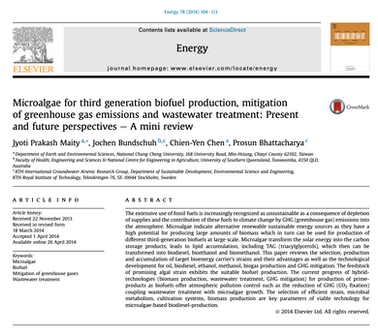
Biofuels
An alternative to traditional fossil fuels that are often derived from feedstocks such as biomass or microbial fermentation processes. Biofuels come in the form of liquid ethanol or biodiesel following the processing of such feedstocks.
Biofuels act as clean sources of energy conversion, aiming towards carbon neutrality, and are completely renewable in nature.
What are Biofuels?
Evolution of Biofuel Production
Source feedstocks include crops such as corn, wheat, sugarcane, etc. Biochemical and thermochemical conversion of source biomass to bioethanol products. Reduces greenhouse gas emissions associated with fossil fuels, but depletes crops (food vs. fuel debate).
first generation biofuels
Source feedstocks include lignocellulosic biomass from waste. Biochemical and thermochemical conversion of source biomass to liquid bioethanol, biomethanol, or biodiesel. Generated to move away from edible feedstocks.
second generation biofuels
Source feedstocks are microbially derived. Microbes like microalgae are fast-growing and abundant, thus improving the yield and speed at which biofuels can be produced. Biochemical and thermochemical conversion is still required, but with extensive downstream processing to acquire effective biofuels.
third generation biofuels *
Source feedstocks are microbially derived and genetically engineered. Microbes like microalgae are genetically engineered to increase the efficacy with which they convert carbon sources to usable biofuel sources through improved metabolic processing. Higher production and reduced processing.
fourth generation biofuels *
What are the environmental impacts of fossil fuel emissions?
Climate Change
As human populations rise, so does the contribution to anthropogenic sources of greenhouse gases such as carbon dioxide, as our reliance on fossil fuels steadily increases. Accumulation of carbon dioxide in the atmosphere from the burning of fossil fuels leads to amplification of the greenhouse effect, thus warming or Earth and leading to climate change as time progresses (Jain 2001). The impacts of climate change on the environment are wide and long-lasting, including rising sea levels, increased incidence of drought, and more frequent severe weather events. These environmental disasters associated with fossil fuel combustion emissions could go as far as rendering the Earth uninhabitable in a sixth mass extinction event (Soeder 2020).
Ocean Acidification
With rising atmospheric carbon dioxide levels resulting from fossil fuel combustion, oceans are absorbing this carbon dioxide at an increased rate. Oceans have previously had the capacity to buffer the changes in pH caused by atmospheric carbon dioxide absorption through the use of bicarbonate, acting as a carbon sink; however, with an excess of carbon dioxide, the ability of oceans to buffer these changes has been significantly reduced (Findlay 2021). As the ocean slowly acidifies and temperatures rise, aquatic organisms will be greatly impacted, most notably through overproductivity of microbial life to sequester the excess carbon, thus consuming large amounts of oxygen and leading to hypoxia (Findlay 2021).
Human Health & Air Pollution
As combustion products from fossil fuels continue to pollute the air, detrimental impacts on public health are seen as a result. Increased atmospheric greenhouse gases have been linked to increased disease incidence as well as an increase in mortality with increasing concentrations (Kopel 2019). The burning of fossil fuels contributes greatly to fine particulate matter found in the atmosphere as well. This leads to smog formation alongside severe systemic complications when inhaled (Kopel 2019). Accumulation of particulate matter within the lungs exacerbates the symptoms and prevalence of many pulmonary diseases (Kopel 2019).

Biofuel Mighty Microbes
Saccharomyces cerevisiae, also better known as brewer's yeast, is one of the most common microbes used in bioethanol production via fermentation pathways. S. cerevisiae fermentation of starch products has been well researched to produce bioethanol alongside lower concentrations of methanol (Anthoni 2007). Over time, this process has been refined with additional downstream processing, such as enhanced filtration techniques, in an effort to improve the quality of the resulting ethanol. Continuous fermentation of Saccharomyces cerevisiae with various sugar products used as a carbon source is the most popular choice for large-scale industrial production of biofuels, and thus has had the largest impact on the reduction of fossil fuel emissions (Kumar 2017). S. cerevisiae biofuel research is now primarily focused on genetic engineering to enhance yield and purity (Buzzell 2016).

Saccharomyces cerevisiae
Sugar based carbon source, large-scale industrial production
Microalgae are single-celled organisms with a high growth rate and the ability to accumulate high-energy carbohydrates, making them suitable for biofuel production; thus, microalgae have been thoroughly researched as a feedstock for third-generation biofuels (Chang 2014). The capability of microalgae to conduct photosynthesis has also aided their use as biofuels, as they sequester environmental carbon to generate algal carbohydrates utilized for bioethanol (Chen 2013). Downstream processing of these biofuels can often be complex, including several biochemical treatments; therefore, bioengineering as well as nanoparticle technology have been researched to aid in this processing (Du 2024). If these processes can be streamlined, biofuels from this route could effectively reduce carbon emissions through sequestration (Chang 2014).

Microalgae
Carbon sequestration, high-energy carbohydrate feedstock
Cyanobacteria
Cyanobacteria have been identified as a useful sink for greenhouse gas emissions outside of biofuel production due to their capacity to both fix nitrogen as well as sequester atmospheric carbon dioxide. Their ability to photosynthesize and fix nutrients also makes them successful biofuel producers (Lalnunpil 2023). Their species richness also aids in biofuel production as they can capture a wide range of feedstocks as sources for biofuels such as biodiesels, bioethanols, and more (Lalnunpil 2023). Cyanobacteria can also be genetically modified to enhance productivity, with evidence shown in the engineering of metabolic pathways to better fit the demand of commercial biofuel production. Preferential production of secondary metabolites within cyanobacteria can improve the yield of biofuels through the generation of higher energy carbohydrates (Hellingwerf 2015).












